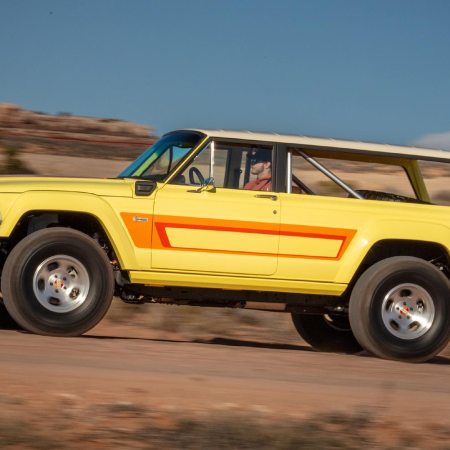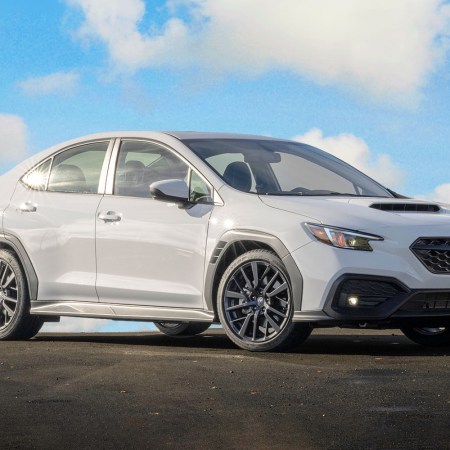If you drive a sedan, an older model car or even a pickup from the ‘90s, once you get into heavy traffic, one thing becomes abundantly clear: pickup trucks these days seem — to use the technical term — really freaking big.
No, you’re not going crazy. It actually plays out in the data. Last week, we came across a chart from Oak Ridge National Laboratory, tweeted out by the director of Infrastructure Policy at the Center for American Progress, showing a 32% increase in the average weight of pickup trucks between 1990 and 2018.
The responses to this chart on Twitter range from someone positing that “most of them, including the lifted ones, are just used for commuter vehicles.” Another user talks about buying a Toyota Tacoma 10 years ago, “which was the smallest available,” but still much larger than the older model he was upgrading from. But the big question is, simply, why is this happening?
To answer that, we called up Dan Edmunds, Director of Vehicle Evaluation at Edmunds.com [the identical name is just a coincidence], who tags the constant growth with three main points, and one you may not expect.
The Switch From Imports to American Models
“In the ‘90s, I worked for Toyota Technical Center in Arizona and I was involved in truck development, so T100, first Tacoma, first Tundra, so I’ve been through that and I see what it is now,” Edmunds told InsideHook. Before then, going back to the 1970s, a lot of the trucks on the roads were whatever automakers were selling globally. “Even the Toyota Hilux, which is what Marty McFly wants in Back to the Future, that was still an imported truck.”
Then the Toyota Tacoma came along in 1995, which Edmunds notes was the first pickup Toyota designed for the U.S. market. By following the lifespan of that truck, you can get a good look at the pickup industry as a whole: “We’re in the third generation now, but in 2005 [when the second generation launched], that’s where the Tacoma got bigger. It went from compact to midsize. This is industry-wide, everybody seemed to do that at about the same time … What was going on in trucks generally was they were moving from regular cabs to extended cabs to crew cabs.”
The Supremacy of the Crew Cab
If you’re not familiar with truck lingo, a crew cab is a pickup with four front-hinged doors and two rows of seats, as opposed to the older standard of a two-door regular cab. Edmunds illustrates the watershed crew cab moment like this: previously when you went to a dealer to buy a pickup, they’d show you the regular cab and flippantly mention the crew cab. Starting in the aughts, the car salespeople started showing the larger trucks first.
That’s not to say it’s all on the dealers and automakers. “When crew cabs became available on something like an F-150 or a Tacoma, suddenly people were buying them for more family use,” Edmunds said. “Then once you do that, it’s like, well it’d be nice to have a little more legroom. So in more recent times, RAM and Chevy and everybody has extended their wheelbase to make the rear seat even more pleasant.”
That transition from work vehicles to personal vehicles had a ripple effect, with half-ton and heavy-duty trucks getting bigger and more powerful in step with the lighter duty trucks. “Almost instantly, the crew cab became the number-one selling configuration,” he said. “So then the whole design philosophy started to change around the crew cab.”
Obama-Era Fuel Regulations
More or less, all of this makes a lot of sense. Americans like using pickups for personal use, and once we get a little taste of something we like, we want, as Tim Taylor said, more power. But when Barack Obama became president and we as country started to have conversations about fuel economy, wouldn’t we have seen a decrease in the size of trucks? Actually, it was the opposite.
In the Obama era, Edmunds explained, fuel economy regulations “changed from just a straight average across the board to what’s called a platform-based fuel economy standard. So your fuel economy target for a given vehicle is based on its wheelbase and its tread width, which is the width between the tires left to right. So if you multiply that you find the area of that rectangle and there’s a table that shows what your fuel-economy target is. The bigger the vehicle, the smaller the target.”
In other words, the regulations put in place to get better mileage out of vehicles also led to an increase in truck size. “There was kind of an incentive to maybe stretch the wheelbase a couple of inches and set the tires maybe an inch [farther] apart, because you get a bigger platform and slightly smaller target,” said Edmunds. “Now, the bigger vehicle would be heavier and might use more fuel, so it’s not as easy as just doing that. But certainly there was a feeling that if they did need to make it bigger to accommodate more passengers, the fuel economy target wouldn’t be onerous. They could do it.”
In the end, those standards also mean — unfortunately for people like the Twitter commenter who bemoaned the Tacoma’s size increase — that we probably won’t see a return to true compact pickup trucks. But what about electric trucks? Isn’t there a possibility that we’ll see smaller EV pickups once those finally start hitting the market?
“Oh, certainly,” said Edmunds. When it comes to electric vehicles, while the technology isn’t there yet, he had two words: “Anything’s possible.”
This article was featured in the InsideHook newsletter. Sign up now.


















